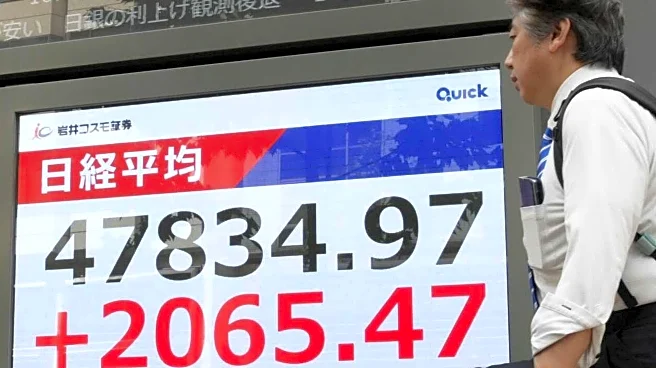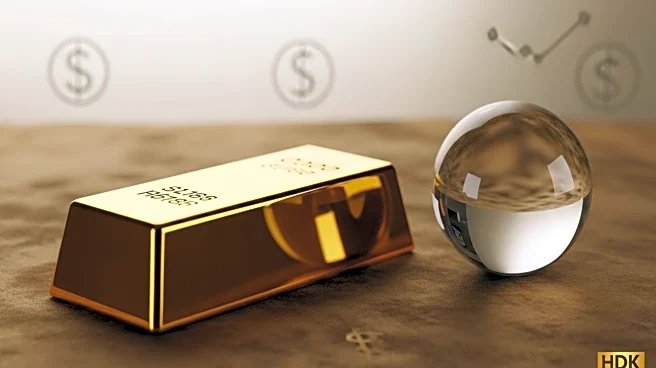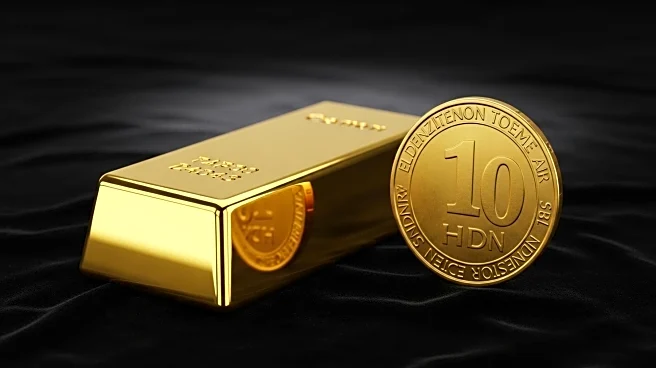What's Happening?
Gold prices have reached a historic high, surpassing $3,900 per ounce for the first time. This surge is attributed to increased safe-haven demand, driven by a combination of factors including a decline in the yen, the ongoing U.S. government shutdown, and expectations of further interest rate cuts by the Federal Reserve. Spot gold rose by 1.1% to $3,929.91 per ounce, while U.S. gold futures for December delivery increased by 1.2% to $3,954.70. The yen's weakness, following the election of fiscal dove Sanae Takaichi as Japan's ruling party leader, has left investors seeking alternative safe-haven assets, with gold emerging as a preferred choice. The U.S. government shutdown continues to cast uncertainty over the economy, potentially impacting GDP. The Federal Reserve's anticipated rate cuts are further bolstering gold's appeal as a non-yielding asset in a low-interest-rate environment.
Why It's Important?
The rise in gold prices highlights the current economic uncertainties and the shifting dynamics in global financial markets. As a traditional safe-haven asset, gold's appeal increases during periods of economic instability and geopolitical tensions. The ongoing U.S. government shutdown and potential mass layoffs of federal workers add to the economic uncertainty, prompting investors to seek refuge in gold. Additionally, the Federal Reserve's expected rate cuts could further weaken the dollar, making gold more attractive to investors. This trend reflects broader concerns about the stability of the global economy and the effectiveness of monetary policies in addressing these challenges. The surge in gold prices also indicates a growing demand for alternative investments amid volatile market conditions.
What's Next?
Investors are closely monitoring the Federal Reserve's upcoming decisions on interest rates, with additional cuts anticipated in October and December. These rate cuts could further influence gold prices, as lower interest rates typically enhance the appeal of non-yielding assets like gold. The ongoing U.S. government shutdown and its potential economic impact remain critical factors to watch. If the shutdown persists, it could lead to further economic disruptions and increased demand for safe-haven assets. Market participants will also be attentive to any developments in U.S. fiscal policies and their implications for the broader economy. The trajectory of gold prices will likely continue to be influenced by these economic and geopolitical factors.
Beyond the Headlines
The current economic environment underscores the importance of safe-haven assets like gold in providing stability and security to investors. The rise in gold prices reflects broader concerns about the effectiveness of traditional monetary policies in addressing economic challenges. As central banks around the world navigate complex economic landscapes, the role of gold as a hedge against inflation and currency devaluation becomes increasingly significant. This trend may lead to a reevaluation of investment strategies, with a greater emphasis on diversification and risk management. The ongoing geopolitical tensions and economic uncertainties could also prompt policymakers to explore alternative approaches to ensure economic stability and growth.











